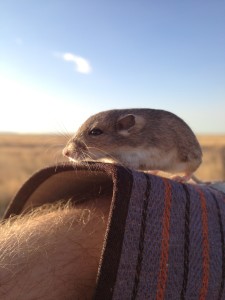MARFA – Rodent researcher Bobby Allcorn had a busy September. Each week the Sul Ross State University graduate student trapped hundreds of small rodents—from petite silky pocket mice to husky wood rats—on the Dixon Ranches Mimms Unit. That’s great news for a host of other wild animals.
“The effects of the Rock House Fire, combined with the drought, devastated the small rodent population,” said Allcorn, whose research is funded by the Dixon Water Foundation, a non-profit that promotes healthy watersheds through sustainable land management. “These animals do rebound with precipitation though. And they’re coming back in force.”

While the drought persists, recent rains have been a boon to small rodents, like this silky pocket mouse found on the Dixon Ranches Mimms Unit near Marfa. (By Bobby Allcorn/Borderlands Research Institute)
In 2011, the Dixon Water Foundation partnered with Dr. Bonnie Warnock of Sul Ross’s Borderlands Research Institute to monitor the small-rodent population on the Mimms Unit. Then the historic Rock House Fire burned most of the ranch on Marfa’s northwest edge.
Without vegetation to eat or hide in, the number of mice and rats crashed, to the point that researchers rarely caught a rodent. The effects ricocheted throughout the food web, from bobcats to quail.
“Predators eat small rodents, so if there aren’t any small rodents, larger animals become prey more often,” Allcorn said. “For example, pronghorn really suffered after the fire. Not only was there no forage for them, but predators went after them more.”
Small rodents play other roles in maintaining healthy grasslands. They disperse seeds and can even alter the plant composition of an area.
“They’re a representation of overall ecological health,” Allcorn said.
Allcorn will finish his small-rodent research next year, at which point he’ll be able to draw more conclusions.
“But for now I can say the population and diversity have certainly increased since last year, due to the rainfall,” Allcorn said. “That’s a great thing for all the other animals and the environment.”

